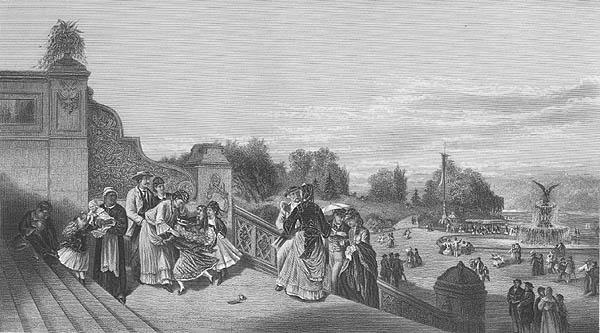|
THE TERRACE CENTRAL PARK NEW YORK |

A HIGH QUALITY STEEL ENGRAVING BOOKPLATE FROM THE 1870'S!!
PERFECT FOR FRAMING AS AN ART PRINT FOR YOUR DEN !!
VERY ANTIQUE & OLD WORLD LOOKING. ITEM(s) OVER 125 YEARS OLD!!
![]()
Manhattan has several parks, the largest being Central Park, designed (1850s) by Frederick Law Olmsted and Calvert Vaux (1824-1895) which has graced Manhattan from 59th to 110th streets since the late 1850s. It contains a zoo (opened in 1864; now officially called the Central Park Wildlife Conservation Center), an open-air theater, several lakes, a large reservoir, and recreational facilities. The romantic style of landscape architecture was first introduced in North America by Thomas Jefferson at Monticello, his Virginia estate, but the most important example of this style is Central Park. It was the first major public example of landscape architecture in the U.S. and was so successful both as a municipal enterprise and as a work of art that by 1870 it had influenced the creation of public parks, many of them designed by Olmsted and Vaux, all over the nation. Bethesda Terrace is on two levels, united by two grand staircases and a lesser one that passes under Terrace Drive to provide passage southward to the Elkan Naumburg bandshell and The Mall, of which this is the architectural culmination, the theatrical set-piece at the center of the park. The upper terrace flanks the 72nd Street Cross Drive and the lower terrace provides a podium for viewing the Lake. The mustard-olive colored carved stone is New Brunswick sandstone, with a harder stone for cappings, with granite steps and landings, and herringbone paving of Roman brick laid on edge. Bethesda Terrace became a site for an outdoor luncheon restaurant at the end of the 1960s, then became a congregating spot for the Hair generation before devolving into a drug-trafficking venue in the 1970s. The fountain, which had been dry for decades, was restored in its initial campaign, 1980–81, by the Central Park Conservancy as the centerpiece of its plan to renovate Central Park. The Terrace, designed by Vaux with sculptural decoration by Mould, was restored in the following season, its stonework disassembled, cleaned, deteriorated surfaces removed, restored and patched and reset. Resodding, and fifty new trees, 3,500 shrubs and 3,000 ground cover plants specified by Philip Winslow followed in 1986, most of which, having matured into dense blocks, were removed in 2008, to make way for plants native to the United States. The Minton encaustic tiles of the ceiling of the arcade between the flanking stairs, designed by Mould, were removed in 1987, cleaned, restored, completed with additional new tiles and reinstalled in 2007. Following an illustration in an 1891 book by the Superintendent of Planting in Central Park, Calvert Vaux's assistant and partner, Samuel Parsons, today in summer, the lower basin once again has water lilies, lotus and papyrus, grown in removable pots. Bethesda Fountain is the central feature on the lower level of the terrace, constructed in 1859-64, which is enclosed within two elliptical balustrades. The pool is centered by a fountain sculpture designed by Emma Stebbins in 1868 and unveiled in 1873. Stebbins was the first woman to receive a public commission for a major work of art in New York City. The bronze, eight-foot statue depicts a female winged angel touching down upon the top of the fountain, where water spouts and cascades into an upper basin and into the surrounding pool. It was the only statue in the park called for in the original design. Beneath her are four four-foot cherubs representing Temperance, Purity, Health, and Peace. Also called the Angel of the Waters, the statue refers to the Gospel of John, Chapter 5 where there is a description of an angel blessing the Pool of Bethesda, giving it healing powers. In Central Park the referent is the Croton Aqueduct opened in 1842, providing the city for the first time with a dependable supply of pure water: thus the angel carries a lily in one hand, representing purity, and with the other hand she blesses the water below. The base of the fountain was designed by the architect of all the original built features of Central Park, Calvert Vaux, with sculptural details, as usual, by Jacob Wrey Mould. In Calvert Vaux and Frederick Law Olmsted's 1858 Greensward Plan, the terrace at the end of the Mall overlooking the naturalistic landscape of the Lake was simply called The Water Terrace, but after the unveiling of the angel, its name was changed to Bethesda Terrace. The panels of carving in the abstracted organic style propounded by Owen Jones, a mentor of the sculptor Jacob Wrey Mould are organized by an iconographical program of themes: the Seasons, the Times of Day, the Ages of Mankind. Considerable latitude was offered the carvers executing the work, following Ruskinian principles.
![]()
SIZE: Image size is 5 1/4" x 9 3/8", overall page size is 8 1/2" x 12".
CONDITION: Condition is clean, nothing on reverse.
SHIPPING: Buyers to pay shipping/handling, domestic orders receives priority mail, international orders receive regular mail.
We pack properly to protect your item!
An engraving is an intaglio process of printing, with the design to be produced is cut below the surface of the plate (made of copper, steel or wood), and the incised lines are filled with ink that is then transferred to paper. The portraits on our currency are good examples of engraved images. A Photogravure is an intaglio process in which the plate is produced photographically. The item(s) being sold is an image on paper made from the original master and IS NOT a block of wood or steel.
IMAGE IS MUCH SHARPER AND CLEARER THAN SCAN SHOWS !!
AN ACTUAL PRINT FROM THE 1870's!

Powered by eBay Turbo Lister
The free listing tool. List your items fast and easy and manage your active items.